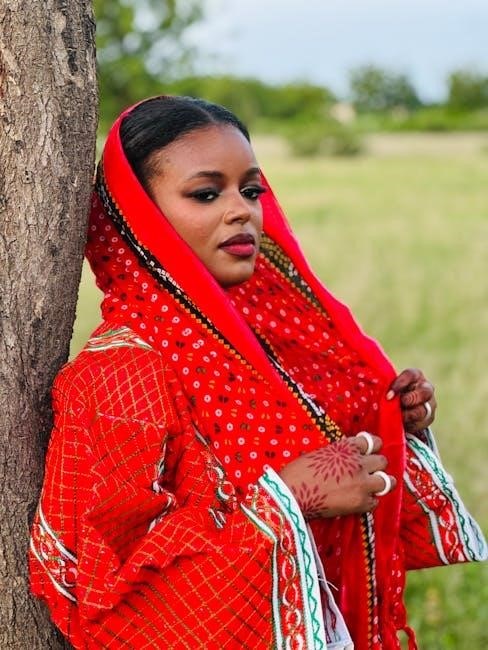Understanding the correct bra size is essential for comfort, health, and confidence. This guide provides expert tips and step-by-step instructions to help you find your perfect fit and explore styles suited to your body type.
1.1 Importance of Correct Bra Size
A correct bra size is crucial for both comfort and health. Properly fitted bras prevent discomfort, back pain, and poor posture. They also ensure optimal breast support, reducing the risk of long-term damage. A well-fitting bra enhances confidence and allows clothes to fit better. Expert fitters emphasize that a bra should feel almost invisible when worn correctly. Incorrect sizing can lead to issues like spilling over or gapping cups, which can be addressed by accurate measurements. Regular updates to your size are essential, as factors like weight changes or exercise can alter your fit over time. Prioritizing the right size ensures all-day comfort and support.
1.2 Brief Overview of Bra Sizing
Bra sizing consists of two key measurements: band size and cup size. The band size is determined by measuring around your torso, just under your bust, and is typically represented by even numbers. Cup size is calculated by subtracting the band measurement from your bust measurement, with each inch representing a specific cup letter (A, B, C, etc.). Proper sizing ensures comfort, support, and a flattering fit. Variations in sizing can occur between brands, so consistency and accurate measurements are crucial for finding the perfect bra. Understanding these basics is the first step to achieving a great fit.

Basics of Bra Sizing
Bra sizing combines band and cup measurements to ensure a perfect fit. The band size is your torso measurement, while cup size reflects the difference between bust and band size.
2.1 Understanding Band Size
The band size is measured around your torso, directly under your bust, where the bra band sits. It should feel snug but not restrictive. To measure accurately, wrap a flexible tape measure level around your body, ensuring it’s parallel to the floor. If the measurement is an odd number, round up to the nearest even number for your band size. A well-fitting band provides most of the bra’s support, so accuracy is key. Proper fit ensures comfort and prevents issues like digging or riding up. Different bra styles may slightly alter band size, but the core measurement remains consistent.
2.2 Understanding Cup Size
Cup size is determined by the difference between your bust and band measurements. Subtract your band size from your bust size to find your cup size. For example, if your bust measures 37 inches and your band size is 34 inches, the difference is 3 inches, which corresponds to a C cup. Each inch represents a cup size: 1 inch is A, 2 inches is B, and so on. Proper cup fit ensures your breasts fill the cups without spilling over or gapping; Accurate measurement is crucial for comfort and support, as ill-fitting cups can lead to discomfort or visible lines under clothing.

How to Measure Your Bra Size
Measure your band size by wrapping a tape measure around your torso under your bust. For cup size, measure the fullest part of your bust while wearing a non-padded bra. Ensure the tape is level and not too tight for accurate results. Use a mirror to check proper alignment and take deep breaths to ensure comfort and precision in your measurements.
3.1 Measuring Your Band Size
To measure your band size, wrap a flexible tape measure around your torso directly under your bust, where the bra band sits. Ensure the tape is parallel to the floor and not too tight. The measurement in inches or centimeters gives your band size. For accuracy, wear a non-padded bra or no bra at all. If the number is odd, round up to the nearest even number. Stand up straight and take a deep breath to ensure the tape isn’t too restrictive. Proper alignment is key for a comfortable and supportive fit. This step is foundational for determining your bra size accurately.
3.2 Measuring Your Cup Size
To measure your cup size, wrap the tape measure around the fullest part of your bust while keeping it level and parallel to the floor. Ensure the tape isn’t too tight by taking a deep breath in and out. Subtract your band size from this measurement to determine your cup size. For example, if your bust measures 37 inches and your band size is 34, the difference is 3 inches, corresponding to a C cup. Proper cup fit means your breasts fill the cups without spilling over or leaving gaps. If your breasts are asymmetrical, fit the smaller one for comfort. Ensure the cups aren’t too tight or digging into your skin for optimal support and comfort. This step ensures your bra provides the right level of coverage and support. Accurate cup size is crucial for both comfort and aesthetics, making it a vital part of your bra sizing process.
3.3 Tips for Accurate Measurements
For precise measurements, wear a non-padded, non-push-up bra or no bra at all. Stand upright and relax your shoulders to ensure accuracy. Use a flexible tape measure and keep it level and parallel to the floor. Avoid pulling the tape too tight or twisting it, as this can distort results. Take a deep breath to ensure the tape isn’t compressing your body. If your breasts are asymmetrical, measure the larger one for cup size. Double-check your measurements to confirm consistency. For the most accurate fit, consider having someone assist you with the measurements. This ensures a proper fit and supports your comfort and confidence.

Bra Size Calculator and Charts
Bra size calculators and charts simplify finding your perfect fit by converting measurements into accurate sizes, ensuring comfort and support tailored to your unique body shape.
4.1 Using an Online Bra Size Calculator
Online bra size calculators simplify the process of determining your perfect fit. By entering your band and cup measurements, these tools provide instant results, ensuring accuracy and ease. Many calculators guide you through measuring your underbust and bust size, converting the numbers into your ideal bra size. They often include charts to help you understand variations in sizing across brands. Using a calculator saves time and reduces guesswork, offering a convenient way to find your size from home. Regular updates and brand-specific options make them a reliable resource for maintaining comfort and support.
4.2 Interpreting Bra Size Charts
Bra size charts are essential tools for understanding your measurements. They map band and cup sizes, helping you identify your fit based on standard sizing. Charts typically include numerical or alphabetical cup sizes and corresponding band measurements. By matching your measurements to the chart, you can determine your size accurately. Keep in mind that sizes may vary slightly between brands, so charts often include conversion guides. They also account for different body types and bust shapes, ensuring a more personalized fit. Regularly consulting a chart can help you maintain the perfect size as your body changes over time.

Factors Affecting Bra Fit
Weight changes, exercise routines, and breast shape variations can impact bra fit. Hormonal fluctuations and body changes over time may require adjustments to maintain comfort and support.
5.1 Weight Gain or Loss
Weight fluctuations significantly impact bra fit. Gaining weight can increase both band and cup sizes, while weight loss may reduce them. Changes in body composition, such as fat distribution, can alter how bras fit. It’s essential to remeasure your bra size after significant weight changes to ensure proper support and comfort. Even a small weight change can affect how the band sits or how the cups fit. Regularly assessing your size helps maintain the best fit and prevents issues like gapping or spillage. Professional fitters can also provide guidance during these transitions to ensure optimal comfort and support.
5.2 Exercise and Muscle Tone
Exercise and muscle tone can influence bra fit, particularly in the band and straps. Increased muscle mass, especially in the shoulders or back, may require a larger band size for comfort. Regular physical activity can also lead to changes in body composition, affecting how the bra sits. For instance, strength training might result in a firmer bust, potentially altering cup size. It’s important to remeasure your bra size after significant changes in muscle tone or exercise routines. Proper fit ensures optimal support and prevents discomfort or restricted movement, especially during physical activities. Regular check-ins with a professional fitter can help maintain the best fit.
5.3 Breast Shape and Size Variations
Breast shape and size variations, such as asymmetry or differences in fullness, can impact bra fit. Asymmetrical breasts may require fitting the smaller side first, ensuring the bra accommodates both. Rounded or East-West shapes might need specific cup styles for proper containment. Significant size differences can cause spillage or gapping, while uniform shapes may fit standard cups easily. Understanding your breast shape helps in selecting the right bra style. Regular measurements and professional fittings can address these variations, ensuring comfort and support regardless of breast shape or size differences. Proper fit is key to avoiding discomfort and ensuring optimal bra performance.
Different Types of Bras and Their Sizing
Different bras, like full-coverage, sports, or push-up styles, cater to various needs. Each type has unique sizing considerations to ensure proper fit, comfort, and support.
6.1 Full-Coverage Bras
Full-coverage bras offer extensive support and modesty, ideal for larger busts or those seeking maximum coverage. They typically feature underwired cups, wide straps, and sturdy bands for added stability. The sizing for full-coverage bras prioritizes a snug, comfortable fit without constriction. Ensure the cups fully encapsulate your breasts, with no spilling or gapping. The band should sit firmly around your torso to prevent shifting. These bras are perfect for everyday wear, providing both functionality and confidence. Proper sizing ensures all-day comfort and optimal support, making them a great choice for various body types and preferences.
6.2 Sports Bras
Sports bras are designed for active women, offering superior support and comfort during physical activities. They come in various styles, including compression and encapsulation types. Proper sizing is crucial to ensure optimal performance and prevent discomfort. The band should fit snugly, while the cups should fully contain your breasts without restricting movement. Moisture-wicking fabrics are common, enhancing breathability. Many sports bras feature adjustable straps and wide bands for added stability. Whether low-, medium-, or high-impact, the right size ensures a secure fit, allowing you to focus on your workout without distractions. Correct sizing maximizes support and minimizes discomfort during exercise.
6.3 Push-Up and Minimizer Bras
Push-up bras are designed to enhance cleavage by pushing breasts upward and inward, creating a fuller appearance. They often feature padding or underwire for added lift and support. Minimizer bras, on the other hand, are tailored to reduce the visible size of larger busts, offering a more streamlined silhouette. Both styles require precise sizing to ensure comfort and effectiveness. Proper fit ensures that push-up bras don’t dig or cause discomfort, while minimizer bras provide adequate coverage without constriction. Understanding your body type and needs is key to choosing the right style for optimal support and confidence.
6.4 Strapless and Convertible Bras
Strapless bras are designed to stay in place without straps, often featuring adhesive or boning for support. Convertible bras offer versatility, with removable or adjustable straps to suit various outfits. Both styles are ideal for dresses or tops that reveal the shoulders. Proper fit is crucial, as strapless bras rely on a snug band and secure cups to stay in place. When choosing these styles, ensure the band fits tightly and the cups cover your breasts fully. Quality and fit are key, even if they require a little more effort to get right.

How to Choose the Right Bra for Your Body Type
Choosing the right bra involves understanding your body type and needs. Experts offer tailored tips to ensure optimal support, comfort, and style for every shape.
7.1 Petite Frames
Petite frames require bras that provide proportionate support without overwhelming the body. Look for styles with narrower straps and bands that fit snugly to avoid slipping. Avoid overly padded or bulky designs, as they can appear disproportionate. Opt for minimal coverage or demi-cup bras to enhance natural shape. Ensure the band size is accurate, as a too-loose band can cause discomfort. Consider seamless or soft-cup bras for a flattering fit. Pay attention to fabric quality for comfort and durability. Regularly reassess your size, as weight changes or muscle tone can affect fit. Properly fitted bras enhance confidence and overall comfort for petite frames.
7.2 Larger Busts
For larger busts, prioritize bras with strong structural support, such as underwire or seamed cups, to maintain shape and reduce strain. Opt for wide, adjustable straps to distribute weight evenly and prevent digging. Ensure the band fits snugly, as it provides most of the support, but avoid overtightening, which can cause discomfort. Look for bras with multiple hooks or a sturdy back band for added stability. Avoid minimizer bras if they cause compression or discomfort. Consider professional fittings to address unique needs, as standard sizes may not always fit perfectly. Proper support enhances comfort, reduces back pain, and improves posture for larger busts.
7.3 Asymmetrical Breasts
For individuals with asymmetrical breasts, finding the right bra can be challenging but achievable. Start by measuring each breast separately to determine the best fit. Focus on the smaller breast to avoid gapping in the cup, while ensuring the larger breast is fully contained. Look for bras with adjustable cups, removable padding, or moldable cups to balance the appearance. Seamless or stretchy bras can also accommodate size differences. Properly fitted straps and a comfortable band are key to preventing discomfort. Professional fittings are highly recommended to address asymmetry effectively. With the right style and fit, asymmetrical breasts can achieve comfort and confidence.

Common Bra Fit Issues
Common bra fit issues include gapping cups, spilling over, and digging straps. These problems can cause discomfort, poor posture, and difficulty finding the right style. Addressing these ensures better support and confidence.
8.1 Gaping Cups
Gaping cups occur when there is space between the bra cups and your breasts, often due to a too-large cup size or incorrect style. This issue can cause discomfort and affect the overall appearance of your outfit. To address gapping cups, try a smaller cup size or opt for a different bra style that better suits your breast shape. Weight fluctuations or changes in breast shape can also lead to this problem. Ensuring a proper fit and exploring various styles can help eliminate gaps, providing a more flattering and comfortable fit for everyday wear.
8.2 Spilling Over
Spilling over occurs when your breasts exceed the bra cups, causing discomfort and an unflattering appearance. This usually happens when the cup size is too small or the style doesn’t suit your breast shape. To fix this, try a larger cup size or opt for a full-coverage bra. Ensure the band fits snugly around your torso to prevent the cups from riding up. Adjusting the straps can also help, but if the issue persists, it may be time to explore a different bra style altogether for better support and a more comfortable fit.
8.3 Digging Straps
Digging straps can cause discomfort and even lead to long-term issues like poor posture or shoulder pain. This often happens when the bra straps are too tight or the band size is incorrect, shifting the weight unevenly. To address this, adjust the straps to a comfortable tension and ensure the band fits snugly without being too tight. If the issue persists, consider a bra with wider straps or a style that distributes weight more evenly, such as a racerback or T-back design. Proper fit ensures all-day comfort and support without sacrificing style or functionality.

Adjusting Your Bra for the Perfect Fit
Proper adjustments ensure optimal comfort and support. Tighten or loosen straps to redistribute weight evenly, and ensure the band sits snugly without restricting movement for a seamless fit.
9.1 Tightening or Loosening Straps
Adjusting bra straps is crucial for comfort and support. Tighten straps if the cups gape or slide down, ensuring breasts are secure without digging into shoulders. Loosen if straps feel too constricting or cause discomfort. Proper strap adjustment ensures even weight distribution, preventing shoulder pain and promoting a smooth silhouette. Regular checks and tweaks can extend bra lifespan and maintain a perfect fit. Balance is key: straps should support without restricting movement, ensuring all-day comfort and confidence.
9.2 Ensuring the Band Fits Properly
The bra band should sit level and snug around your torso, providing primary support. It should not ride up or feel too tight, restricting breathing. A well-fitting band lies parallel to the floor and stays in place without shifting. To test the fit, you should be able to slip two fingers comfortably under the band. If it digs into your skin, it’s too tight, while a loose band may cause the cups to gape. Adjusting the band ensures optimal comfort and prevents issues like back pain or poor posture. Proper band fit is essential for all-day support and confidence.

The Role of a Professional Bra Fitter
A professional bra fitter offers expertise in accurate measurements, personalized style recommendations, and ensures a perfect fit, enhancing comfort and confidence.
10.1 Benefits of a Professional Fitting
A professional bra fitting ensures accuracy and personalization, addressing unique needs like asymmetrical breasts or comfort concerns. Experts provide tailored recommendations, enhancing comfort, posture, and confidence while preventing issues like digging straps or gapping cups. Their knowledge of various styles and sizes helps find the perfect fit, making daily life more comfortable and enjoyable. Regular fittings are crucial, especially after body changes, to maintain optimal support and ensure bras continue to fit well over time. This personalized approach is invaluable for achieving long-lasting comfort and confidence.
10.2 What to Expect During a Fitting
During a professional bra fitting, a trained expert will assess your body type and needs. They will measure your band and cup size, ensuring accuracy. You’ll try on various styles and sizes, receiving feedback on fit, comfort, and support. The fitter will address concerns like gapping cups or digging straps, offering solutions. Expect personalized recommendations to enhance your comfort and confidence. The process is discreet and tailored to your preferences, helping you find bras that fit perfectly and meet your lifestyle needs. This expert guidance ensures a supportive and flattering fit every time.

How to Care for Your Bras
Hand wash bras with mild detergent, avoiding bleach. Reshape while wet to maintain form. Store in a cool, dry place to prolong lifespan and elasticity.
11.1 Washing and Drying Tips
Hand wash bras with a mild detergent in cold water to preserve elasticity and fabric quality. Avoid using bleach or harsh chemicals, as they can damage materials. Gently massage the fabric instead of wringing or twisting to prevent stretching. For machine washing, use a delicate cycle and a lingerie bag for protection. Air dry bras by laying them flat or hanging them away from direct sunlight to maintain shape and avoid color fading. Reshape cups while wet to ensure they retain their form during drying.
11.2 Storage Recommendations
To maintain the shape and quality of your bras, store them in a cool, dry place away from direct sunlight. Avoid folding or stacking bras, as this can distort their shape. Instead, lay them flat or hang them by the straps in a well-ventilated area. Use a drawer or storage box specifically designed for lingerie to protect delicate fabrics; Acid-free tissue paper can be placed between bras to prevent moisture and odor buildup. Ensure bras are clean before storage, as dirt and oils can weaken elastic over time. Proper storage extends the lifespan of your bras and keeps them looking their best.
Proper bra fit is crucial for comfort, health, and confidence. This guide provides comprehensive steps to measure, choose, and care for your bras, ensuring a perfect fit every time.
12.1 Summary of Key Points
Accurate bra sizing is vital for comfort and support. Measure your band size by wrapping a tape around your torso under your bust, ensuring it’s level and snug. Cup size is determined by the difference between your bust and band measurements; Use online calculators or charts for precise sizing. Factors like weight changes, exercise, and breast shape can affect fit. Regular measurements ensure your size remains accurate. Proper fit prevents issues like gapping cups or digging straps. Investing in quality bras and seeking professional fittings can enhance comfort and confidence. Remember, the right bra promotes better posture and overall well-being.
12.2 Final Tips for Maintaining a Perfect Fit
Regularly reassess your bra size to ensure a continued perfect fit, as factors like weight changes or new exercise routines can alter your measurements. Always hand-wash delicate bras and avoid heat to maintain their shape. Store bras properly to prevent stretching or deformation. Replace bras when they show signs of wear, such as frayed straps or a loose band. Remember, a well-fitting bra not only enhances comfort but also boosts confidence and supports long-term breast health. By following these tips, you can maintain a flawless fit and enjoy the benefits of a perfectly sized bra.
